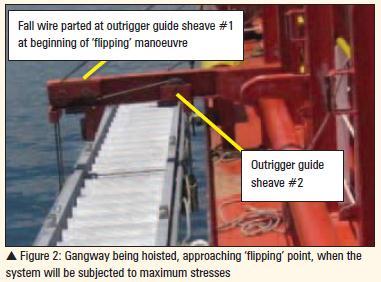201065 Gangway fall wire parted
Gangway fall wire parted
MARS Report 201065


Arriving for a canal transit, the vessel had rigged the starboard accommodation ladder to facilitate the transfer of immigration, customs personnel, agents, ship chandlers etc and to embark canal pilots. All these transfers were safely executed, after which the crew started heaving up the ladder in order to secure it in its recess in preparation for the first lock. When the ladder was hoisted to the upper deck level and it was being flipped inboard under power, the fall wire rope parted about two metres from its inboard end thimble eye, in the way of the outrigger's outboard guide sheave. The gangway fell down and hung vertically along the ship's side. Fortunately, no one was injured. The fallen gangway was recovered and secured, and the parted wire was renewed with a new spare. As a precaution, the port gangway's fall wire rope was thoroughly inspected and was found to be deformed at the same corresponding section. This wire was also renewed and a satisfactory hoisting and static load test on both port and starboard accommodation ladders was undertaken.
Investigation of the incident showed no evidence of breach of either company procedures or statutory regulations; however there was non-compliance with the guidance as given in the Chapter 18.6 of the Code of Safe Working Practice, which requires periodical maintenance of the equipment for means of access.
Root cause/contributory factors
Company procedures do not give specific guidance on how to carry out periodical maintenance/status control of the accommodation ladders, including the wire falls, other than stating that the inspection should be carried out by a responsible person;
Company procedures require a control over the condition of the accommodation ladders every time they are put in service, however these do not include a specific requirement for an effective control over the condition of the wire falls;
Although the visual inspection was done in accordance with company requirements, considering the position where the wire parted (see Figures 1 to 3, p18), we have to assume that due to difficulty of access, this particular part of the wire fall was neither thoroughly maintained nor inspected, although overall greasing of the wire falls was carried out monthly and recorded in the monthly maintenance reports.
Corrective/preventative actions
Fall wires were renewed on both accommodation ladders and thereafter they were closely inspected and successfully tested under load;
Safety officers will be duly trained on how to carry out safety inspection on board the vessels;
Company quality, safety and environmental (QSE) manual is being revised to include specific instructions/guidance on how and when to carry out inspections;
The safety officer inspection checklist has been amended with specific requirements over the control of the condition of all wire falls;
Inspection guidance to also include instructions related to components/parts that are not easily accessible, to ensure that their condition is properly verified;
Incident report circulated to the fleet. Masters have been instructed to include discussion about this incident at the next monthly QSE committee meeting minutes;
Analysis of this incident has been included in the agenda of future company seminars;
Vessels have been instructed to inspect fall wires and safely carry out both hoisting and static load tests of accommodation ladders immediately, report results and forward evidence of the condition status to the company;
Company's safety inspection check list has been upgraded in order to include specific instructions for the attending superintendent.
Lessons learnt
Incidents are not necessarily more likely on older vessels. In this case, the vessel was less than two years old and the parted fall wire was manufactured about 27 months before its failure;
Components and parts of equipment that are not readily accessible must be inspected and maintained with particular care as they may deteriorate faster than the rest of the system.
Editor's note: In this arrangement, the wire fall will have permanent high stress-points on the sections in way of the sheaves when the winch begins flipping the gangway and outrigger together. This perhaps explains why the fall wire parted precisely at that time and location. Apart from the strain at these points, constant exposure to wind and sea and difficult access can prevent proper inspection and maintenance of the wire fall. A dry pivot bearing of outrigger can also impose additional load, so proper greasing and lubrication of all moving parts is important.
Finally, inadvertent over-tightening of gangway (and lifeboat) wire falls during stowage can impose excessive loads for long periods on the system.
It is not clear in the report if the gangway hoisting system was fitted with an operational limit switch. Such a safety device will ensure that during final stowing, the power is cut off before the system is overstressed due to operator error. The final tightening of wire falls must be always done manually and only efficient sea lashings must bear the dynamic loads at sea.
It is also suggested that the makers of the accommodation ladder and the wire falls be informed of the incident, with a request for a recalculation of maximum stress in the system. If appropriate, a larger diameter wire for the falls may have to be used. This will require the replacement of all sheaves as well.
